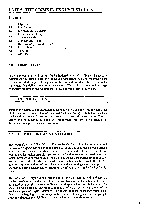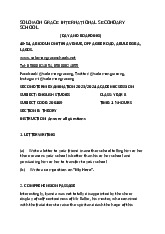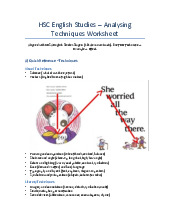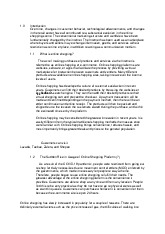













Preview text:
Comprehensive Guide to the Development and Theoretical
Foundations of Literary and Cultural Studies
Development of English Studies as an Academic Subject
The academic discipline of English studies has a relatively recent history,
primarily emerging in the 19th century. Initially, higher education in England
was a Church of England monopoly, with only Oxford and Cambridge
Universities offering degrees. These institutions were structured as small,
monastic-like colleges, exclusively admitting male Anglican
communicants who attended college chapels, and whose teachers were
unmarried, ordained ministers. The curriculum focused heavily on
classics—Greek and Latin literature—alongside divinity and mathematics,
effectively excluding Catholics, Jews, Methodists, atheists, and others from
the professions and civil service.
The push for reform began in the early 19th century, culminating in the
founding of University College London in 1826, which aimed to award
degrees to individuals of all religions or none. By 1828, English language
was offered as a subject, and the first Professor of English was appointed
in 1829. Initially, English was studied mainly as a linguistic subject, using
literature as a source of linguistic examples rather than as a focus of literary analysis.
The recognition of English literature as a distinct academic discipline
gained momentum with the establishment of colleges like Girton (1869)
and Newnham (1875) at Cambridge, which provided education for women
—though women could not receive degrees at Oxford until 1920 and at
Cambridge until 1948. Similarly, at London University, women from Bedford
College could take exams and receive degrees from 1879 onward. The
American context saw even earlier progress, with institutions like
Wesleyan College (1839) and Oberlin College (1850) awarding degrees to
women and Black women, respectively.
Early scholars like F. D. Maurice (appointed at King’s College in 1840)
emphasized the importance of studying English literature as a means of
emancipation and national identity, linking the discipline to political and
social stability. Maurice believed literature could serve as a secular
substitute for religion, fostering a sense of national belonging and middle-class values.
The initial focus on language and moral education was intertwined with the
Victorian desire to maintain social order and control, often viewing
literature as a tool for moral uplift and cultural cohesion. Over time, the
discipline expanded to include literary history, language studies, and
critical analysis, gradually developing into a more systematic academic field.
Liberal Humanism in Literary Studies
For much of the 19th and early 20th centuries, liberal humanism
dominated English studies. This approach holds several core beliefs:
Timelessness of great literature: Works are seen as enduring,
transcending their historical context to speak to universal human values.
Autonomy of the text: The meaning of a literary work is contained
within the words themselves, independent of socio-political or biographical contexts.
Close reading: Emphasis on detailed, verbal analysis of texts, focusing
on language, form, and imagery without external interference.
Moral and aesthetic purpose: Literature is valued for its capacity to
propagate humane values and enhance life, often with a moral or spiritual dimension.
Individuality and the 'transcendent subject': The belief that each
person has a core, unchanging essence, and that literature reflects
authentic human nature.
Form and content: An organic unity where style, imagery, and
structure are seen as inseparable from the work’s meaning.
Sincerity and truth-to-experience: Literature should be honest,
avoiding clichés and superficiality, and expressing genuine emotion.
Anti-ideological stance: Criticism should be disinterested and
detached from political or social agendas, aiming to see the work as it truly is.
Distrust of ideas: The focus is on sensuous immediacy rather than
abstract theories or intellectualized explanations. This perspective,
often called liberal humanism, was rooted in English empiricism—
trusting in direct sensory experience and reason as the basis for understanding literature.
Practical Criticism and Close Reading
A hallmark of liberal humanist practice is practical criticism, pioneered by
I. A. Richards in the 1920s. This method involves close, detailed analysis
of texts in isolation, removing external historical or biographical contexts
to uncover internal meanings. The goal is to interpret the words on the
page through verbal and formal analysis, emphasizing precise language,
imagery, and structure.
Scholars like William Empson and F. R. Leavis further developed this approach:
Empson’s Seven Types of Ambiguity (1930) explored the multiple
meanings and verbal complexities within texts, emphasizing linguistic indeterminacy.
Leavis focused on moral and aesthetic judgments, advocating for
values of vitality and life in literature, often through moral critique.
This tradition prioritized textual autonomy, viewing literature as a self-
sufficient entity that could be understood through careful, systematic analysis.
Key Theoretical Contributions from Classical to Modern Times
The roots of literary theory extend back to Ancient Greece, notably
Aristotle’s Poetics (4th century BC), which laid foundational ideas about
tragedy, character, plot, and catharsis—the emotional release
experienced by the audience. Aristotle emphasized character and action
as central to tragic effect and introduced the idea of empathy and
sympathy as crucial audience responses.
In the Renaissance, Sir Philip Sidney’s Apology for Poetry (c. 1580) argued
that literature’s primary purpose is to teach and delight, emphasizing
pleasure as a central aim of poetry, a departure from purely moral or
religious views of literature.
The eighteenth-century critic Samuel Johnson advanced the idea of
practical criticism, offering detailed commentary on individual authors
like Shakespeare, thus establishing a tradition of biographical and textual analysis.
The Romantic poets—Wordsworth, Coleridge, Keats, Shelley—
challenged earlier formalist views, emphasizing emotion, imagination, and
the unconscious. Wordsworth’s Preface to Lyrical Ballads (1800) argued
for a poetry rooted in common speech and personal emotion,
advocating for the expression of genuine feeling over formal artificiality.
Coleridge’s Biographia Literaria further explored the nature of poetry,
emphasizing language’s imaginative power and the role of the unconscious.
Shelley (1821) viewed poetry as a transformative force that strips away
familiarity, aiming to awaken the reader’s perception. He also
distinguished between the author’s personal experience and the poet’s
craft, foreshadowing later ideas of impersonality.
T. S. Eliot (early 20th century) introduced concepts like dissociation of
sensibility, impersonality, and the objective correlative—the idea that
emotions are best expressed through concrete symbols rather than
direct statement. Eliot’s impersonality emphasized the voice of tradition
over individual expression, and his objective correlative sought a
symbolic vehicle to evoke emotion.
Transition from Liberal Humanism to Critical Theory
From the 1960s onward, critical theory challenged the assumptions of liberal humanism:
It rejects essentialism, asserting that identity categories (gender,
race, class) are socially constructed and fluid.
It emphasizes that all thinking is shaped by ideological commitments,
making disinterested analysis impossible.
It posits that language constructs reality, and meaning is co-created
by reader and text—a view rooted in post-structuralism.
Texts are inherently ambiguous and unstable, with multiple, shifting meanings.
It distrusts universal claims, such as the idea of great literature or
human nature, viewing them as Eurocentric or masculinist constructs.
This approach has led to pluralism in criticism, with feminist,
postcolonial, postmodern, and identity-based theories emphasizing
diversity, context, and power relations.
Recurrent Fundamental Ideas in Critical Theory
Despite methodological differences, several core ideas recur across critical theories:
Social construction: Many categories (gender, race, identity) are not
fixed but created by social forces.
Language as a shaping force: Words do not merely reflect reality but
shape it; meaning is jointly produced by reader and writer.
Provisional truths: There are no absolute or fixed truths; knowledge is
always contingent and context-dependent.
Anti-essentialism: The idea that universal human nature or
greatness is a myth, often masking power dynamics.
Politics is pervasive: All interpretations and categories are
embedded within political and ideological frameworks.
Conflicts and Debates in Literary Criticism
Historically, debates such as those between F. R. Leavis (advocating moral
and aesthetic standards) and René Wellek (calling for explicit
theoretical foundations) highlight tensions between practical, value-
based criticism and theoretical, systematic approaches.
Similarly, the rise of theory in the 1960s and 1970s, with structuralism,
post-structuralism, feminism, and postcolonialism, often challenged the
foundations of liberal humanism, leading to crises and divisions within
the discipline. Critics argued that explicit theory was necessary to clarify
methods and expose biases.
Impact of Gender and Social Inclusion on the Discipline
Progress in gender and social inclusion significantly influenced the discipline:
Women gained access to degrees in the late 19th and early 20th
centuries, with institutions like Bedford College and London University leading the way.
Recognition of marginalized groups and postcolonial voices has
expanded the scope of literary studies, emphasizing diverse
perspectives and power relations.
The development of feminist, postcolonial, and identity-based
criticism reflects a broader social commitment to inclusion,
representation, and deconstruction of dominant narratives.
This comprehensive overview traces the evolution of English and literary
studies from their origins rooted in religious and moral education to a
pluralistic, theory-rich discipline that continuously redefines itself
through critical debates, social change, and theoretical innovation.#
Comprehensive Guide to the Development and Theoretical Foundations of Literary and Cultural Studies
Development of English Studies as an Academic Subject
The academic discipline of English studies has a relatively recent history,
primarily emerging in the 19th century. Initially, higher education in England
was a Church of England monopoly, with only Oxford and Cambridge
Universities offering degrees. These institutions were structured as small,
monastic-like colleges, exclusively admitting male Anglican
communicants who attended college chapels, and whose teachers were
unmarried, ordained ministers. The curriculum focused heavily on
classics—Greek and Latin literature—alongside divinity and mathematics,
effectively excluding Catholics, Jews, Methodists, atheists, and others from
the professions and civil service.
The push for reform began in the early 19th century, culminating in the
founding of University College London in 1826, which aimed to award
degrees to individuals of all religions or none. By 1828, English language
was offered as a subject, and the first Professor of English was appointed
in 1829. Initially, English was studied mainly as a linguistic subject, using
literature as a source of linguistic examples rather than as a focus of literary analysis.
The recognition of English literature as a distinct academic discipline
gained momentum with the establishment of colleges like Girton (1869)
and Newnham (1875) at Cambridge, which provided education for women
—though women could not receive degrees at Oxford until 1920 and at
Cambridge until 1948. Similarly, at London University, women from Bedford
College could take exams and receive degrees from 1879 onward. The
American context saw even earlier progress, with institutions like
Wesleyan College (1839) and Oberlin College (1850) awarding degrees to
women and Black women, respectively.
Early scholars like F. D. Maurice (appointed at King’s College in 1840)
emphasized the importance of studying English literature as a means of
emancipation and national identity, linking the discipline to political and
social stability. Maurice believed literature could serve as a secular
substitute for religion, fostering a sense of national belonging and middle-class values.
The initial focus on language and moral education was intertwined with the
Victorian desire to maintain social order and control, often viewing
literature as a tool for moral uplift and cultural cohesion. Over time, the
discipline expanded to include literary history, language studies, and
critical analysis, gradually developing into a more systematic academic field.
Liberal Humanism in Literary Studies
For much of the 19th and early 20th centuries, liberal humanism
dominated English studies. This approach holds several core beliefs:
Timelessness of great literature: Works are seen as enduring,
transcending their historical context to speak to universal human values.
Autonomy of the text: The meaning of a literary work is contained
within the words themselves, independent of socio-political or biographical contexts.
Close reading: Emphasis on detailed, verbal analysis of texts, focusing
on language, form, and imagery without external interference.
Moral and aesthetic purpose: Literature is valued for its capacity to
propagate humane values and enhance life, often with a moral or spiritual dimension.
Individuality and the 'transcendent subject': The belief that each
person has a core, unchanging essence, and that literature reflects
authentic human nature.
Form and content: An organic unity where style, imagery, and
structure are seen as inseparable from the work’s meaning.
Sincerity and truth-to-experience: Literature should be honest,
avoiding clichés and superficiality, and expressing genuine emotion.
Anti-ideological stance: Criticism should be disinterested and
detached from political or social agendas, aiming to see the work as it truly is.
Distrust of ideas: The focus is on sensuous immediacy rather than
abstract theories or intellectualized explanations. This perspective,
often called liberal humanism, was rooted in English empiricism—
trusting in direct sensory experience and reason as the basis for understanding literature.
Practical Criticism and Close Reading
A hallmark of liberal humanist practice is practical criticism, pioneered by
I. A. Richards in the 1920s. This method involves close, detailed analysis
of texts in isolation, removing external historical or biographical contexts
to uncover internal meanings. The goal is to interpret the words on the
page through verbal and formal analysis, emphasizing precise language,
imagery, and structure.
Scholars like William Empson and F. R. Leavis further developed this approach:
Empson’s Seven Types of Ambiguity (1930) explored the multiple
meanings and verbal complexities within texts, emphasizing linguistic indeterminacy.
Leavis focused on moral and aesthetic judgments, advocating for
values of vitality and life in literature, often through moral critique.
This tradition prioritized textual autonomy, viewing literature as a self-
sufficient entity that could be understood through careful, systematic analysis.
Key Theoretical Contributions from Classical to Modern Times
The roots of literary theory extend back to Ancient Greece, notably
Aristotle’s Poetics (4th century BC), which laid foundational ideas about
tragedy, character, plot, and catharsis—the emotional release
experienced by the audience. Aristotle emphasized character and action
as central to tragic effect and introduced the idea of empathy and
sympathy as crucial audience responses.
In the Renaissance, Sir Philip Sidney’s Apology for Poetry (c. 1580) argued
that literature’s primary purpose is to teach and delight, emphasizing
pleasure as a central aim of poetry, a departure from purely moral or
religious views of literature.
The eighteenth-century critic Samuel Johnson advanced the idea of
practical criticism, offering detailed commentary on individual authors
like Shakespeare, thus establishing a tradition of biographical and textual analysis.
The Romantic poets—Wordsworth, Coleridge, Keats, Shelley—
challenged earlier formalist views, emphasizing emotion, imagination, and
the unconscious. Wordsworth’s Preface to Lyrical Ballads (1800) argued
for a poetry rooted in common speech and personal emotion,
advocating for the expression of genuine feeling over formal artificiality.
Coleridge’s Biographia Literaria further explored the nature of poetry,
emphasizing language’s imaginative power and the role of the unconscious.
Shelley (1821) viewed poetry as a transformative force that strips away
familiarity, aiming to awaken the reader’s perception. He also
distinguished between the author’s personal experience and the poet’s
craft, foreshadowing later ideas of impersonality.
T. S. Eliot (early 20th century) introduced concepts like dissociation of
sensibility, impersonality, and the objective correlative—the idea that
emotions are best expressed through concrete symbols rather than
direct statement. Eliot’s impersonality emphasized the voice of tradition
over individual expression, and his objective correlative sought a
symbolic vehicle to evoke emotion.
Transition from Liberal Humanism to Critical Theory
From the 1960s onward, critical theory challenged the assumptions of liberal humanism:
It rejects essentialism, asserting that identity categories (gender,
race, class) are socially constructed and fluid.
It emphasizes that all thinking is shaped by ideological commitments,
making disinterested analysis impossible.
It posits that language constructs reality, and meaning is co-created
by reader and text—a view rooted in post-structuralism.
Texts are inherently ambiguous and unstable, with multiple, shifting meanings.
It distrusts universal claims, such as the idea of great literature or
human nature, viewing them as Eurocentric or masculinist constructs.
This approach has led to pluralism in criticism, with feminist,
postcolonial, postmodern, and identity-based theories emphasizing
diversity, context, and power relations.
Recurrent Fundamental Ideas in Critical Theory
Despite methodological differences, several core ideas recur across critical theories:
Social construction: Many categories (gender, race, identity) are not
fixed but created by social forces.
Language as a shaping force: Words do not merely reflect reality but
shape it; meaning is jointly produced by reader and writer.
Provisional truths: There are no absolute or fixed truths; knowledge is
always contingent and context-dependent.
Anti-essentialism: The idea that universal human nature or
greatness is a myth, often masking power dynamics.
Politics is pervasive: All interpretations and categories are
embedded within political and ideological frameworks.
Conflicts and Debates in Literary Criticism
Historically, debates such as those between F. R. Leavis (advocating moral
and aesthetic standards) and René Wellek (calling for explicit
theoretical foundations) highlight tensions between practical, value-
based criticism and theoretical, systematic approaches.
Similarly, the rise of theory in the 1960s and 1970s, with structuralism,
post-structuralism, feminism, and postcolonialism, often challenged the
foundations of liberal humanism, leading to crises and divisions within
the discipline. Critics argued that explicit theory was necessary to clarify
methods and expose biases.
Impact of Gender and Social Inclusion on the Discipline
Progress in gender and social inclusion significantly influenced the discipline:
Women gained access to degrees in the late 19th and early 20th
centuries, with institutions like Bedford College and London University leading the way.
Recognition of marginalized groups and postcolonial voices has
expanded the scope of literary studies, emphasizing diverse
perspectives and power relations.
The development of feminist, postcolonial, and identity-based
criticism reflects a broader social commitment to inclusion,
representation, and deconstruction of dominant narratives.
This comprehensive overview traces the evolution of English and literary
studies from their origins rooted in religious and moral education to a
pluralistic, theory-rich discipline that continuously redefines itself
through critical debates, social change, and theoretical innovation.



